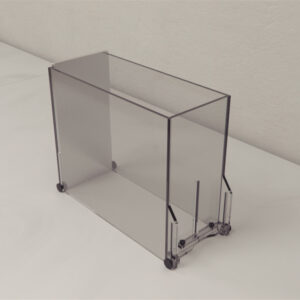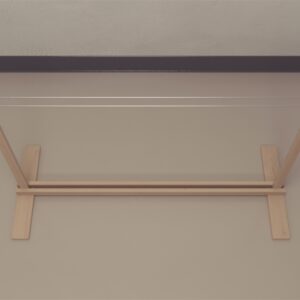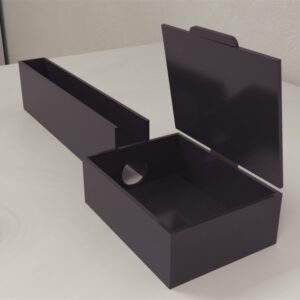$200.00 – $250.00Price range: $200.00 through $250.00
The head bar and head hat system are intended for use with the Maze Engineers Head Fixation Station. The head bar offers a minimally invasive alternative to traditional designs, prioritizing comfort, while the modular head hat safeguards hardware mounted on the head and skull. These systems can be surgically implanted using stereotaxic equipment.
Both the dimensions and specifications of the head bar and head hat are customizable, adjustable, and scalable to accommodate the specific requirements of each laboratory.
Head fixation devices are widely employed in research on anesthesia effects, facial function, neuroimaging, reflex adaptation, operant conditioning, and behaviors such as eye blinking in mice (Schwarz et al., 2010).

MazeEngineers empowers preclinical neuroscience research with meticulously designed, customizable behavioral apparatuses. From manual classic mazes to fully automated smart systems, we provide the tools scientists need to capture high-quality, reproducible data for studies on learning, memory, anxiety, and depression.


bool(false)

Mouse Head Bar Features | |
Sizes available: 20mm-40mm Length X 3.2 Width X 3.2 mm Height | |
Weight 1.1g | |
Composed of Titanium | |
Please include the size required when requesting a quote (customizable sizing available) | |
Customizable sizing available in 1mm increments | |
25 units |
Rat Head Bar Features | |
Sizes available: 40-200mm L in 1mm increments x | |
Composed of Titanium | |
Customizable sizing available in 1mm increments | |
Please include the size required when requesting a quote | |
25 units |

Head fixation serves as a routine procedure in neuroscience research. Its primary objective is to immobilize subjects, facilitating precise experimental control. Beyond motor reflex studies, head fixation devices are instrumental in training mice for operant conditioning tasks within neuroscience laboratories. Additionally, mice with fixed heads can be trained to distinguish auditory, visual, and olfactory stimuli.
The head bar secures subjects to the head fixation station, while the headhat shields head-mounted hardware (such as electrodes and cannulas) from potential damage. Both the head hat and head bar can be tailored in size; refer to our pricing table for standard dimensions.
The head bar is essential for utilizing the head fixation station to manipulate head and eye movements in response to visual stimuli. These dimensions can be adjusted to suit your experimental subjects.
The headhat system is optional, providing protection for skull- or head-mounted devices like cannulas, electrodes, and optogenetic tools. We offer two head hat sizes: a compact version for smaller apparatus like cannula guides, and a larger variant for enhanced protection of multiple probes.
Prior to initiating this procedure, ensure that your laboratory practices comply with applicable animal safety regulations specific to your country and institution.
During surgery using a Stereotaxic Apparatus and while the subject is anesthetized, remove all tissue below the desired attachment site of the head bar on the skull. Score the skull using a scalpel to promote adhesion. Proceed with the planned surgical procedure (implantation, injection, etc.). Confirm compatibility of the head bar with any implants; if necessary, position the head bar before implantation.
Apply Optibond to the exposed skull area and allow it to dry, creating a prepared surface for subsequent adhesive applications. Sterilize the head bar by briefly immersing it in ethanol and let it dry.
Coat the underside of the head bar with cyanoacrylate adhesive and position it on the skull in the desired location, aligning the clip attachment points along the medial-lateral axis. The adhesive should secure within minutes.
Once all implants are in place and surgery is completed, fill the gap between the skull and the head bar with dental cement up to the ledge, ensuring not to overfill to maintain clearance for headhat attachment points. Allow the cement to cure and permit the subject to recover post-surgery.
After the subject has recovered and the adhesive has set, align the headhat with the head bar and firmly press down to secure. The clip mechanism should engage securely with the head bar. To detach the headhat, press the side tabs inward for easy removal.
Rodent behavior and movement can be monitored using video tracking software such as Noldus EthoVision, ANY-Maze, or BehaviorCloud.
The following parameters can be observed using the Octopus three-chambered social apparatus:
The authors present an innovative solution designed to effectively immobilize mice during neuroscientific studies while prioritizing their comfort and ensuring the stability of implanted devices.
The article provides a comprehensive overview of the system’s hardware components, notably featuring a customized 3D-printed head-fixation module. This module enables precise adjustment and stabilization of the mouse’s head position, enhancing experimental accuracy.
A standout feature of the system is its incorporation of an implant-protection mechanism. This includes a transparent protective cap that shields implanted devices from potential damage due to the mice’s movements. Such protective measures significantly enhance the durability and dependability of the implants, facilitating prolonged experimental durations.
In summary, “An open-source solution for head fixation and implant protection in mouse models” offers practical innovations addressing the complexities associated with head fixation and implant safety in mouse-based neuroscience research.
Weaver, I. A., Aryana Yousefzadeh, S., & Tadross, M. R. (2023). An open-source head-fixation and implant-protection system for mice. HardwareX, 13, e00391. https://doi.org/10.1016/j.ohx.2022.e00391
| Head Bar | Mouse Head Bar, Rat Head Bar |
|---|
There are no questions yet. Be the first to ask a question about this product.